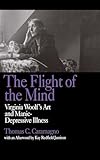The flight of the mind : Virginia Woolf's art and manic-depressive illness. / Thomas C Caramagno.
Material type: TextPublisher number: Atlantic Publishers & Distributors | 7/22, Ansari Road, Darya Ganj, New Delhi.Publication details: Berkeley : University of California Press , ©1992Description: xi, 362 pages. :22cmISBN: 9780520205048Genre/Form: Literature.DDC classification: 823.912 CAR
TextPublisher number: Atlantic Publishers & Distributors | 7/22, Ansari Road, Darya Ganj, New Delhi.Publication details: Berkeley : University of California Press , ©1992Description: xi, 362 pages. :22cmISBN: 9780520205048Genre/Form: Literature.DDC classification: 823.912 CAR | Item type | Current library | Call number | Status | Date due | Barcode | Item holds |
|---|---|---|---|---|---|---|
 Books
Books
|
SNU LIBRARY | 823.912 CAR (Browse shelf(Opens below)) | Available | 25046 |
Browsing SNU LIBRARY shelves Close shelf browser (Hides shelf browser)

|

|

|

|
No cover image available |

|
No cover image available | ||
| 823.912 BLY The mystery of the missing man | 823.912 BLY The secret of Moon Castle / | 823.912 BRO Companion to James Joyce | 823.912 CAR The flight of the mind | 823.912 CHA Try this one for size | 823.912 CHA Believe this ... you'll believe anything | 823.912 CHA Like a hole in the head |
I owned to great egotism the neurotic model in Woolf criticism --
Never was anyone so tossed up & down by the body as I am The sympotom of manic-depression illness --
But what is the meaning of explained it countertransference and modernism --
In casting accounts, never forget to begin with the state of the body genetics and the Stephen family line --
How completely he satisfied her is proved by the collapse emblematic events in family history --
How immense must be the force of life the art of autobiography and Woolf's bipolar theory of being --
A novel devoted to influenza reading without resolution in the voyage out --
Does anybody know Mr. Flanders? Bipolar cognition and syncretistic vision in Jacob's Room --
The sane & insane, side by side the object-relation of self-management in Mrs. Dalloway --
It is finished ambivalence resolved, self restored in To the Light house --
I do not know altogether who I am the plurality of intrasubjective life in the Waves.
The author contends psychobiography has much to gain from a closer engagement with science. Literary studies of Woolf's life have been written almost exclusively from a psychoanalytic perspective. They portray Woolf as a victim of the Freudian "family romance," reducing her art to a neurotic evasion of a traumatic childhood. But current knowledge about manic-depressive illness--its genetic transmission, its biochemistry, and its effect on brain function--reveals a new relationship between Woolf's art and her illness. Caramagno demonstrates how Woolf used her illness intelligently and creatively in her theories of fiction, of mental functioning, and of self structure. Her novels dramatize her struggle to imagine and master psychic fragmentation. They helped her restore form and value to her own sense of self and lead her readers to an enriched appreciation of the complexity of human consciousness.


There are no comments on this title.